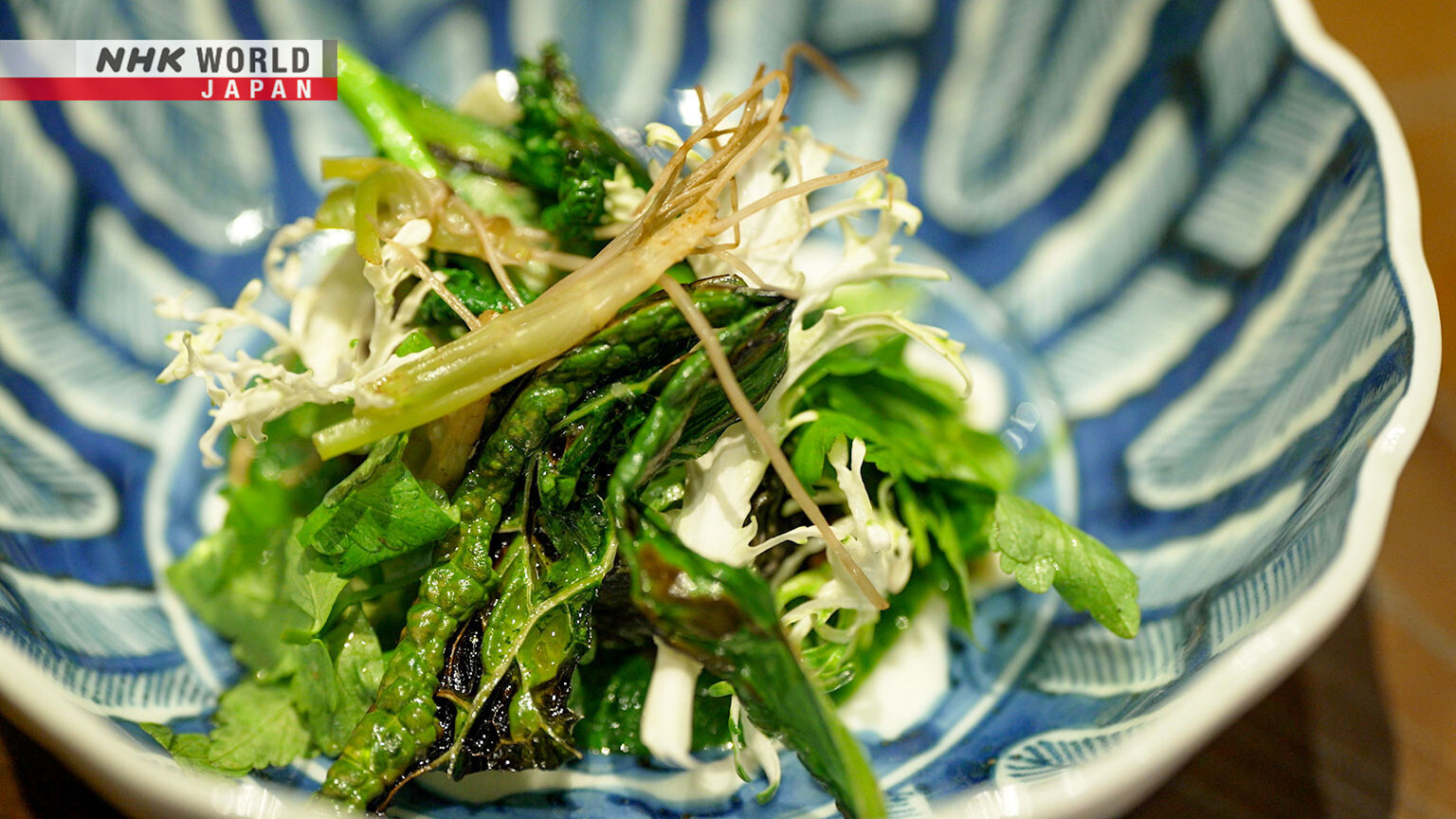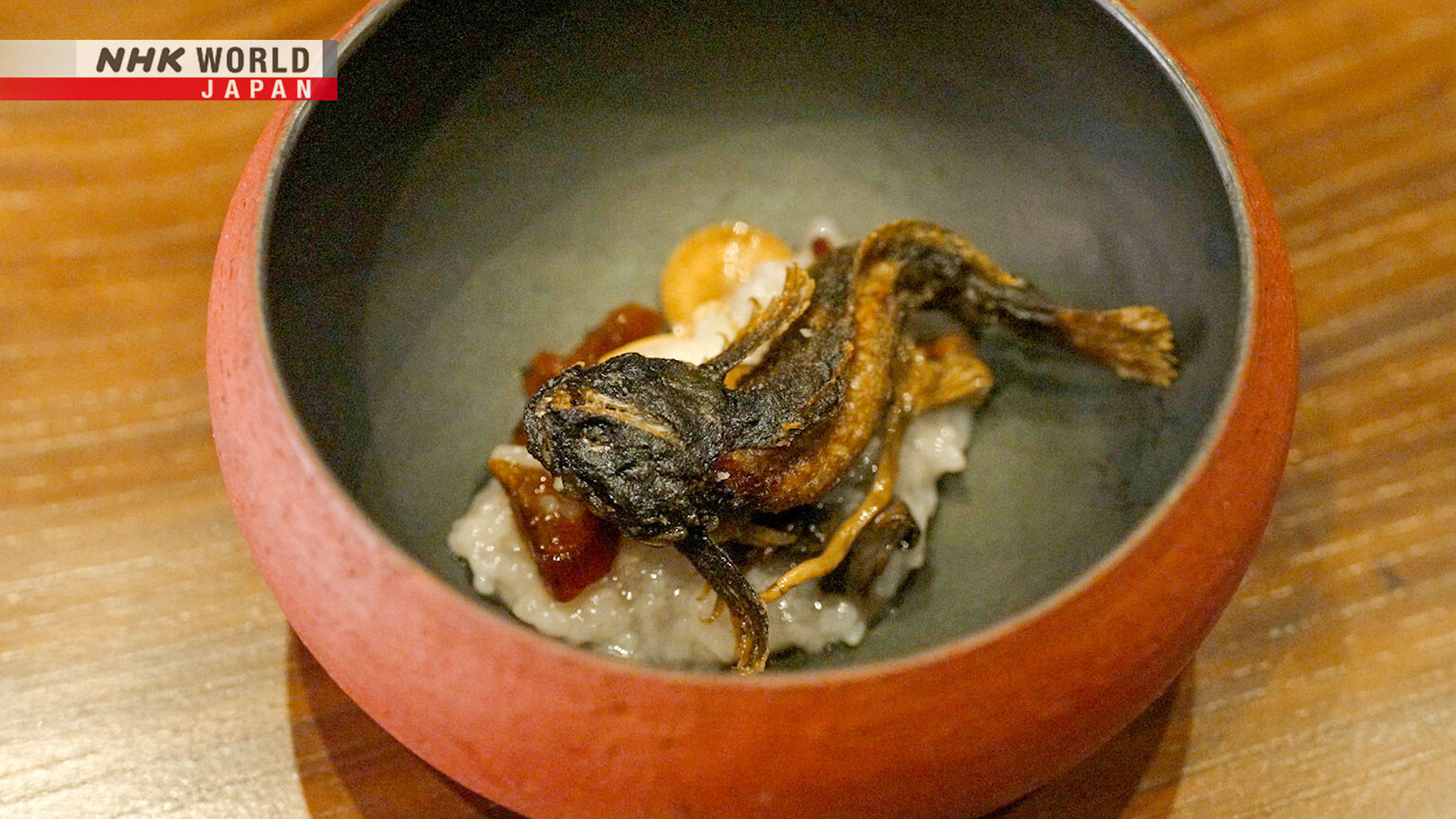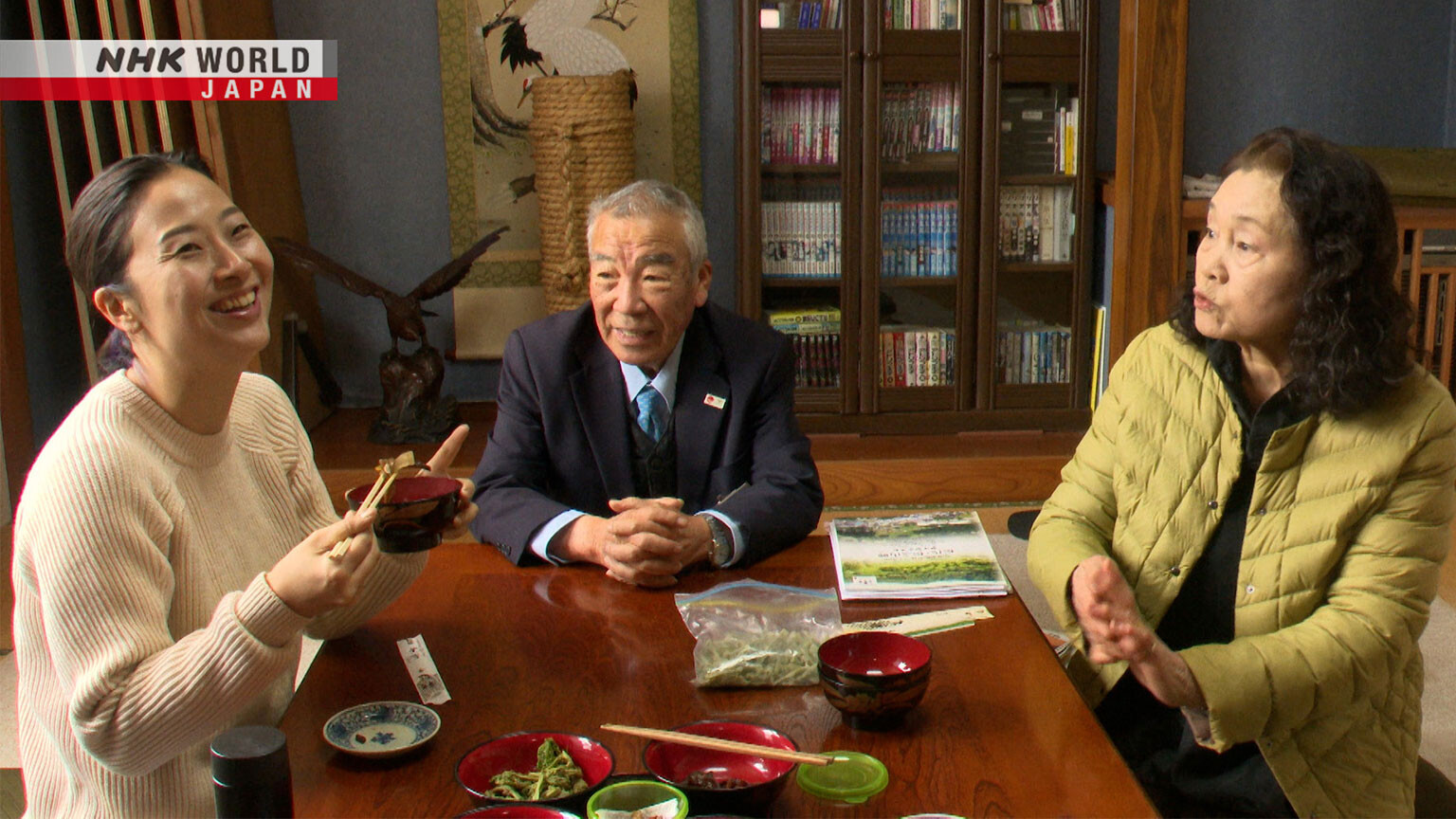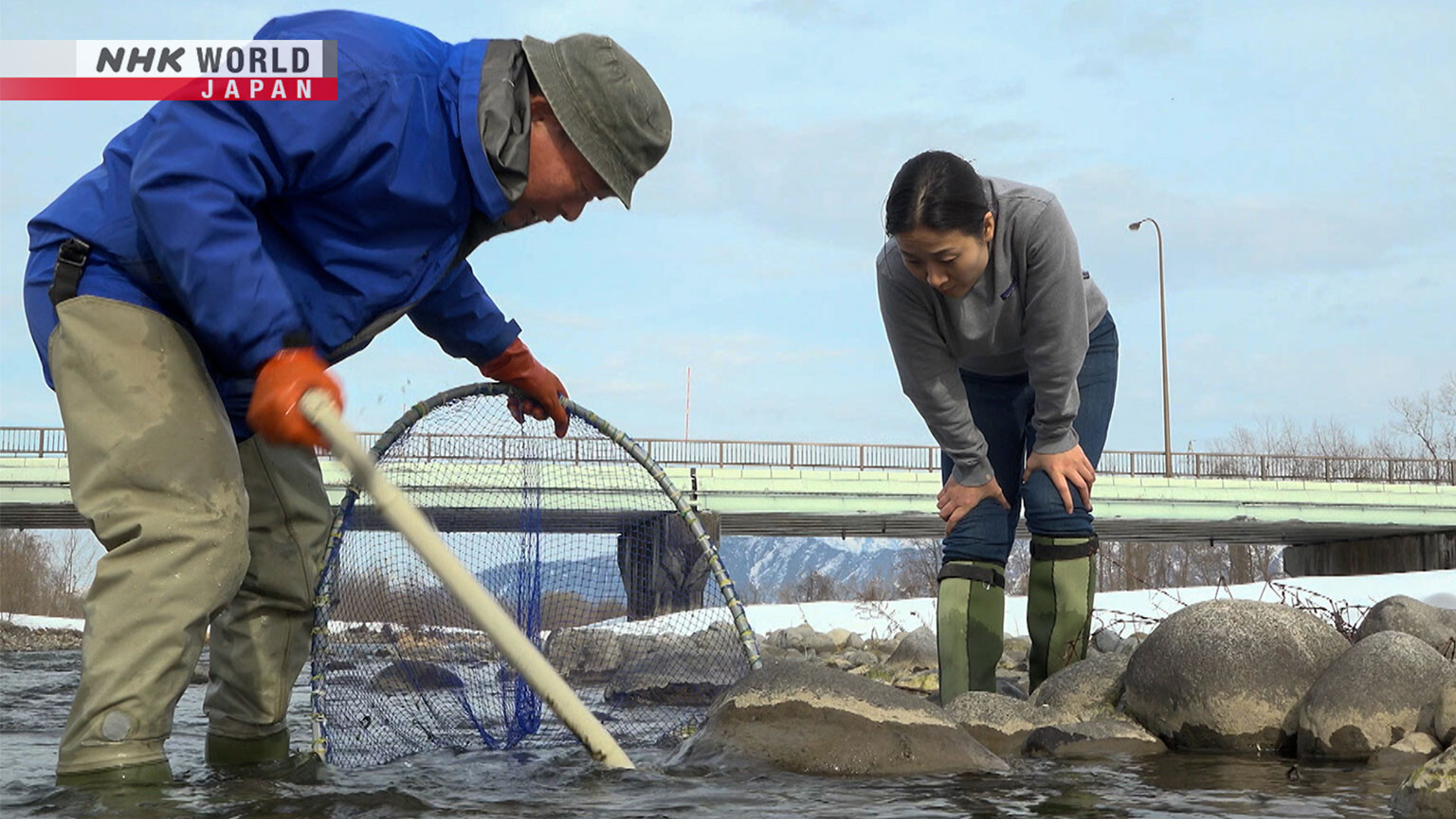Snow Country Chef - Kuwakino Keiko
Globally-renowned chef Kuwakino Keiko uses a new take on traditional methods to showcase the culture, climate and produce of Minami-Uonuma, one of the snowiest places in Japan.




Transcript
FRONTRUNNERS
You only find "yomogi" like this after winter.
You can even eat it raw.
I feel there are principles behind the food that local people eat and enjoy.
I use ingredients I know and love. I want people to come and experience that.
Snow country chef
Kuwakino Keiko
Minami-Uonuma, Niigata Prefecture, is one of Japan's snowiest locations.
It's also home to this auberge-style inn and restaurant
run from a 150-year-old farmhouse.
Next one is snow carrot.
We have a snow hut outside and because of its temperature,
it makes this carrot sweeter.
The head chef is Kuwakino Keiko.
So wonderful. We planned our whole trip around coming here.
No, I'm serious.
Oh, that's so wonderful.
All the flavors mixed together were beautiful,
but the vegetables really, really shined.
A joy to eat because every bite has something to look forward to.
Kuwakino's cuisine, all based around local ingredients,
is earning plaudits from around the world.
As well as rave reviews from leading gourmet guides,
in 2022, her commitment to local produce and culture
won a prestigious Terroir Award.
Kuwakino's day begins with a look through the latest vegetable delivery.
I very rarely ask for specific things, just approximate quantities,
with no idea what I'll get.
Just whatever they have.
Today's bundle includes various items typical of the transition
from winter to spring,
including water dropwort, "asatsuki" chives, and canola sprouts.
The dropwort will go with today's monkfish.
How about this?
Hmmm, let me see...
Today's dinner menu will consist of nine dishes,
which Kuwakino always designs on the fly
once all her ingredients are in front of her.
Asatsuki roots are a bit tough to eat as they are, so we usually fry them.
It's wild, brought down for me from the mountains.
Today, I think I'll pair these with some home-made miso.
She decides to lightly braise these asatsuki roots
to bring out their sweetness.
They're then roughly chopped and mixed with home-made miso
prepared using Niigata soybeans and koji.
For me, the condiments are key.
Of course, the vegetables provide your crucial base,
but the condiments are key to evoking that local flavor.
The resulting combination is served atop mackerel
caught off the coast of Niigata.
With an extra layer of local "hakusai" cabbage, seared and lightly charred.
And finished with a light "espuma,"
made from wild boar stock with local milk and soy sauce,
for a dish that showcases the seasonal bounty of Niigata Prefecture,
both land and sea.
But some of Kuwakino's ingredients come from even closer at hand.
Not far from the back door of her kitchen is a painted maple tree
whose sap she collects to use in her dishes.
It's really full.
So let's take this...
Still dripping, see?
That's the sap.
But strangely, in some seasons you don't get a single drop.
Only in late winter and early spring.
But it's a really big haul today!
Back in the kitchen, Kuwakino quickly boils down the clear, watery sap.
Smell that earthy, alpine aroma?
The end result is this thick, amber syrup,
used to impart a subtle natural sweetness.
Today's next ingredient is kept in a cellar beneath the kitchen.
From spring to autumn, Kuwakino collects local shoots and mushrooms,
which she pickles and bottles for use in winter.
This is salt-pickled bracken.
Picked fresh and salted last year,
it's another example of using local techniques
to showcase the natural flavor of her ingredients.
I picked these around late May last year.
Two batches of 40-plus kilos, so 80 in all.
I pickled the lot and there's almost none left.
It'll all be gone by the end of March.
Another local ingredient preserved by local means is found in the "yukimuro."
Before the onset of winter,
residents of this area traditionally build small thatched huts.
When snow falls, this creates a natural refrigerator, known as a yukimuro.
At zero to minus two degrees and 99% humidity,
you can store vegetables without them drying out.
What's left of my daikon... carrots... and hakusai.
Keeping them here really boosts the natural sugars.
Farmers typically harvest everything around December,
before snow falls, and we store it in here.
With today's ingredients ready, Kuwakino gets to work.
Soaked overnight to ease its saltiness,
the pickled bracken is seasoned with mushroom broth, mirin, and soy sauce.
While the home-made maple syrup is paired with miso dressing
for this watercress salad.
Meanwhile, the "yukimuro hakusai" is paired with home-made "shiokoji."
Along with some locally caught wild boar ham.
So much of the region's culinary tradition combined on a single plate.
(Uono River)
But the highlight of today's menu was caught in the nearby Uono River.
By expert net fisherman, Seki Masatoshi.
Oh wow, you've got one! A beauty!
"Kajika," or fluvial sculpin.
Once prized here as a precious source of protein through the winter months,
in recent decades, it's fallen out of fashion.
When you put grilled kajika in hot sake,
you get a unique broth we call "kajikazake."
I could drink that all day!
In winter these fish lurk beneath rocks on the riverbed,
which Seki expertly manipulates to chase them into his net.
And such first-hand insights into natural cycles
are another thing that Kuwakino tries to reflect in her dishes.
Wow! Amazing!
Yes, quite a few today!
Back in the kitchen, Kuwakino gets down to prepping these fish.
First, I gut them. See over here?
Each tiny fish is gutted and their innards lightly seared in rice oil
before sauteing in sake and soy sauce.
The resulting mix is pressed through a sieve to create a special condiment.
I love fish guts.
The bitterness.
I want all sorts of flavors.
This has a really nice umami.
That real kajika flavor.
Deep fried on skewers,
the fish themselves are soft enough to eat bones and all.
And each receives a liberal daub of the condiment
Kuwakino prepared from their innards.
Served in deep bowls that evoke their rocky hiding place on the riverbed,
these kajika are served with sweet dried persimmon
and miso-pickled Jerusalem artichokes,
for a richly complex taste sensation.
This is the prettiest time.
Days like this, Mt. Makihata tinged with red.
Such a lovely sight.
At 5 PM, dinner is served.
The first dish uses sweet potato from the yukimuro.
Followed by lotus root dumplings in white miso soup.
And the fresh prevernal shoots of water dropwort and canola,
served with grilled sardine and wakame.
And at last, the kajika.
Tonight's guests include regular Sato Yoshinao,
who has dined at Kuwakino's table more than 30 times.
It was nice to see what this year's kajika was like,
as I've had it here many times before.
These multilayered aromas are her signature.
And the main dish is rice farmed right here in Uonuma.
The rice is almost cooked.
But we thought it would be nice for you to enjoy it al dente.
With rice, the turning point from grain to meal
has a firmer texture and characteristic sweetness.
I always look forward to the different rice textures.
You never get bored dining here.
Quite the opposite in fact.
It's packed with new discoveries.
Born in Saitama Prefecture, after graduating from college,
Kuwakino Keiko went to Australia to study aromatherapy.
Next, that same focus on health and beauty saw her drawn to yoga.
In India, she discovered vegan cuisine based on ayurvedic principles,
kickstarting three years of dedication to studying herbs and vegetables.
It was upon her return to Japan
that she chanced across a magazine ad for a kitchen job at this auberge.
Finally arriving in Niigata in January 2014.
I wanted to go home. Right there and then.
I just couldn't stand it.
And there was far more snow than I ever could have imagined.
It was next level.
I just wanted to go straight back home.
And with no clear idea of how Niigata cuisine ought to be,
she embarked upon a lengthy journey of trial and error.
I'd cry every day.
Of course, I couldn't cry in the kitchen,
but every day back in my room.
Patrons would pass all sorts of comments, and they'd leave dishes uneaten.
And I knew I wasn't up to par. It was such a difficult time.
But amid those early tribulations, she found support in the community.
Good morning!
Hi there!
Good morning!
Can I help out?
Help out?
She's like a mother to me.
I couldn't live without her.
I ate here all the time.
Even if I had a cold, she'd tell me to wait for dinner at hers.
Takahashi Tomomi runs this local cafe alongside work on the farms.
Today they're making "anbo,"
braised daikon and carrot steamed in rice dough parcels.
And "sasadango," sweet mugwort dumplings wrapped in bamboo grass.
It's here that Kuwakino learned first-hand how to make countless local dishes.
What's the best dish she makes?
"Shoyu-okowa," I think. She makes it without beans.
Prepping beans is too much hassle.
You learned everything from scratch.
That's right!
Further support came from another local resident
that Kuwakino calls her mentor.
Hi Tatsuzo-san. It's been a while!
Murayama Tatsuzo has been driving taxis in this area for 50 years.
Also an expert at foraging in the surrounding hills,
he taught Kuwakino everything she knows
about picking and preserving alpine plants.
And to download as much of his knowledge as possible, year-round,
she joins him on regular foraging trips into the forest.
We go on these drives together.
But as I always say: foraging's not about looking for things.
It's about sensing them.
But you have to know the local ecosystem.
Right. You'll find nothing without that.
Here we go! Check it out!
Wow! Look at all that fallen fruit!
It's a "kihada" tree, right?
Kihada, or amur cork.
Can you smell the oil?
I can. Kind of citrusy.
The fruit are bitter aren't they?
They sure are!
The name "kihada" comes from this yellow.
"Ki" means yellow.
You can use the fruit as a spice. It has a citrusy aroma.
No citrus in snow country.
Back home, Murayama's wife Masayo
uses the day's pickings to prepare a local favorite.
It's called "mogurajiru," or "mole soup,"
after the affectionate local name for "naratake" mushrooms.
Yay! Mogurajiru!
It uses alpine produce including naratake, bamboo shoots, and fiddleheads,
boiled together with chicken and pork.
What do you use for the stock?
The stock...?
I always ask questions about how she makes stuff.
But mine never turns out like hers.
She shows me the way, but it's not so easy.
So I have to come and ask again. It's an oral tradition.
For Kuwakino, Masayo has been a fountain of knowledge on local vegetable dishes.
Around here, you forage things to eat. That's the culture.
When I was little, my mother took me out into the forest,
so that's where I learned all this.
Six years after moving to Niigata,
Kuwakino finally received Murayama's seal of approval
as an upholder of tradition.
I was so happy to get that certificate.
Mine's the only one, right?
You're the only person I've taught!
Such an honor, more than any award.
Your official license!
A license from my mentor!
And with fewer and fewer locals
taking the time to absorb Niigata's culinary secrets,
Kuwakino sees upholding this tradition as part of her life's mission.
It was in 2018, four years into her stay,
that Kuwakino's mastery of Niigata cuisine saw her appointed head chef.
Isn't it beautiful? Perfect. This is the only season we can do this.
When it comes to traditional recipes,
and the food that local people eat and enjoy,
I feel there are guiding principles behind it all.
But it's not really my place to focus on traditional dishes.
That's an established tradition, and it's full of insights and inspiration,
which I filter through my own sensibilities as a chef.
But it's those local traditions that underpin my cooking.
I don't think I could have made it as a chef in Tokyo,
so I really think I owe everything to this region.
I'm so glad I came here.
In mid-March, a cold snap brings another wave of heavy snows.
But in Kuwakino's kitchen, the heat is on.
The local tourist board has arranged a special event
at which leading chefs from Niigata and Shizuoka
will prepare meals using Niigata produce.
Participants include in-demand Shizuoka chef, Sugiyama Daigo.
Vegetable grower and expert, Imazu Ryo.
And rising Niigata culinary star, Sato Sho.
Alongside Kuwakino herself.
We have last year's wild onion oil. It has a pretty punchy aroma.
The rice with black bean stock was so good it gave me the feels!
Collectively, we need to work out how to use this Niigata produce.
We haven't decided the menu yet.
On the day of the event,
guests from all over Japan are treated to a pre-meal taste of
the traditional winter bonfire custom, "dontoyaki."
The trip is a chance to sample both Niigata's winter and culinary traditions.
Everyone's here, so time for introductions.
We finally fixed the menu a few hours ago.
So I hope you can enjoy this rather ad hoc affair.
In the kitchen, the crack team of chefs gets to work.
So, let's salt pickle these...
It's a genuine collaborative effort.
We don't have the same preservation techniques in Shizuoka.
They were born of necessity,
in a region where you can't find food year-round,
and I think that's so cool.
It's just fascinating. Kuwakino-san is like a magician.
She uses a totally different approach from the rest of us
to showcasing the same qualities in the ingredients.
It's so interesting.
This dish uses fermented soybean tempeh
topped with hair crab and canola shoots.
While here, we have freshly caught shrimp with asiabell roots and turnip.
There's also rice mixed with yukimuro carrot.
And fermented amberjack rolls with watercress and potherb mustard.
Among the guests are famed Thai chef Bo Songvisava
and her husband and collaborator Dylan Jones.
Tonight, dinner is pretty interesting.
It's got a lot of ingredients that I've never heard of.
And also a lot of ingredients that are really famous already,
but the way they were presented, cooked, the flavor is so amazing.
By early April, the snows have begun to recede,
baring the hillsides once more.
It's the cue for Kuwakino to join Murayama for another seasonal foraging trip.
Let's take some of this dogtooth violet.
Yes, there's plenty of it.
Murayama knows that this sun-facing slope
is the surefire site of the earliest spring shoots.
I'm so thankful we can do this every year.
Dogtooth violet. This is a good one.
The nicest gentlest sweetness of all the mountain plants.
Some mugwort.
It can be quite astringent,
but at this time of year it's soft enough to eat as it is.
I just can't stop nibbling.
So what is it that motivates Kuwakino Keiko as a "frontrunner" in her field?
I want everyone to come here.
Of course, there's great food,
but there's more than that, like the bitter shoots and so on.
It's just so rich and complex.
I want people to experience these dishes
that showcase the true power of vegetables.
But as I carry on spreading the word,
it's OK if I'm just one cog in the machine.
I just hope I can help take things to the next level,
in providing delicious experiences for our guests.